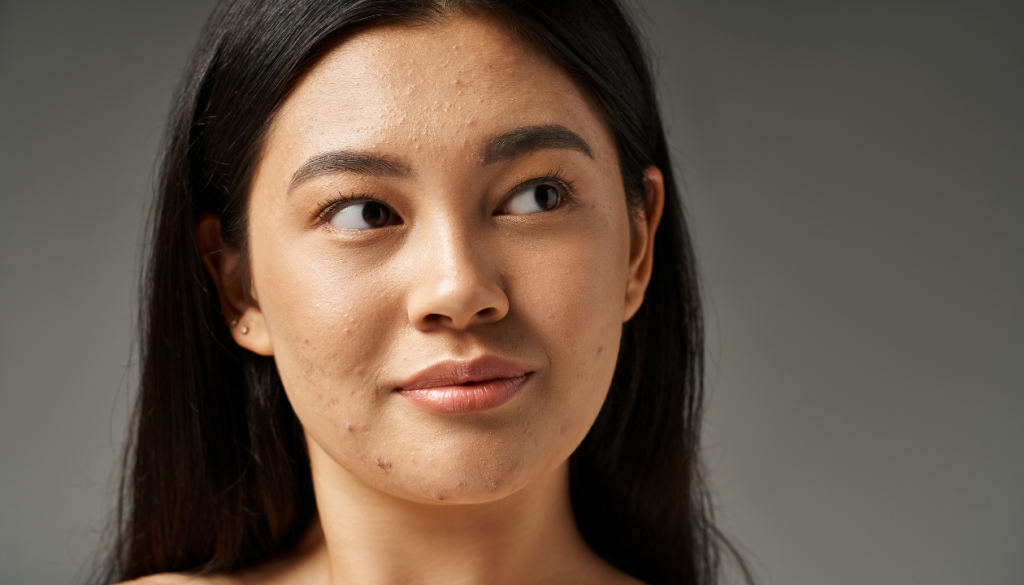If you’re struggling with acne scars, you might be wondering if there’s a solution that can help restore your skin’s smoothness. Microneedling has gained popularity as an effective treatment for diminishing the appearance of these scars.
By creating controlled microinjuries in the skin, this procedure stimulates your body’s natural healing process, leading to increased collagen production and improved skin texture.
This minimally invasive technique is suitable for all skin types, making it an appealing option for many. Clinical studies have shown that microneedling can significantly reduce the visibility of depressed acne scars, providing you with a more even complexion.
With a series of treatments, you could see noticeable improvements, giving you renewed confidence in your skin.
What Is Microneedling?
Microneedling is a minimally invasive procedure that uses a handheld device equipped with tiny sterilized needles to create controlled microinjuries in the skin. These small wounds trigger the body’s natural healing response, stimulating collagen and elastin production. Collagen helps improve the appearance of your skin, filling in fine lines, wrinkles, and scars.
This technique is effective for various skin concerns, including acne scars, stretch marks, and enlarged pores. During the treatment, the depth of needle penetration ranges from 0.5mm to 1mm, depending on the condition being treated and your skin type.
After microneedling, you may experience redness and slight swelling, similar to a mild sunburn, that typically subsides within five days. Since the procedure promotes collagen production, results improve over time, making it a popular choice for individuals seeking to enhance their skin texture and reduce the visibility of acne scars.
How Microneedling Works for Acne Scars
Microneedling effectively addresses acne scars through a specific mechanism that stimulates the skin’s healing processes. This minimally invasive treatment offers several benefits, especially for those dealing with the aftermath of acne.
Mechanism of Action
Microneedling uses a handheld device equipped with fine needles that create controlled microinjuries in the skin. These microinjuries trigger the body’s natural healing response, activating the production of collagen and elastin.
Collagen acts as a building block for skin structure, helping to fill in depressed areas caused by acne scars. The needle penetration depths typically range from 0.5mm to 1mm, tailored to your skin’s condition and type, ensuring optimal results.
As the skin heals, texture improves, leading to a more even, youthful appearance.
Benefits for Acne Scarring
Microneedling offers significant benefits for reducing the visibility of acne scars. Notable improvements occur in skin texture and the overall appearance of depressed scar types, such as rolling and boxcar scars.
Clinical studies document substantial enhancements, making this treatment a promising option. Additional advantages include:
- Versatility: Microneedling suits all skin types and tones, including darker complexions, without damaging the outer layer of skin.
- Minimal Downtime: The recovery period is short, with most side effects like redness and swelling resolving within a few days.
- Synergistic Effect: Combining microneedling with other treatments, such as chemical peels or subcision, enhances overall outcomes and patient satisfaction.
Microneedling stands out as an effective method for rejuvenating your skin and diminishing the appearance of persistent acne scars.
Effectiveness of Microneedling for Acne Scars
Microneedling demonstrates a strong ability to improve the appearance of acne scars through collagen stimulation and natural skin healing. Clinical studies consistently support this treatment’s effectiveness, leading to significant patient satisfaction.
Success Rate
Studies show a high success rate for microneedling in treating acne scars. A systematic review of 33 peer-reviewed studies revealed consistent improvements in scar visibility, with many patients reporting satisfactory results.
For atrophic acne scars, nearly all patients experienced enhanced skin texture and a reduction in scar appearance. Treatment satisfaction spans across various microneedling devices, emphasizing the procedure’s versatility and efficacy.
Duration of Results
Results from microneedling can last several months, depending on individual skin conditions and post-treatment care. After an initial series of treatments, collagen production continues, leading to ongoing improvements in skin texture.
Maintenance sessions every 6 to 12 months can prolong results, ensuring sustained reduction in acne scar visibility and improved skin quality.
Microneedling Process
Microneedling involves a structured approach to ensure effective treatment for acne scars. The process includes several phases: preparation, treatment, and aftercare.
Preparation Before Treatment
Preparation for microneedling starts with a consultation. During this meeting, your skin concerns and treatment goals are discussed. You should arrive with clean skin, free from makeup, lotions, or sunblock.
A numbing cream is applied to reduce discomfort, allowing for a more comfortable procedure. You may receive specific instructions regarding skincare products to avoid prior to treatment. This ensures optimal results and minimizes risks.
Treatment Procedure
During the treatment, your healthcare provider uses a handheld device with tiny sterilized needles to create microinjuries in the skin. The device is gently rolled or moved across the treatment area, with needle depths typically ranging from 0.5mm to 1mm depending on your skin type and condition.
The duration of the procedure varies, generally lasting between 15 minutes to an hour, contingent on the size of the area being treated. You might feel minor prickling sensations, but the numbing cream helps alleviate discomfort.
Aftercare Recommendations
After treatment, some redness and mild swelling may occur, resembling a sunburn. Applying a cool compress can provide relief. It’s essential to keep the skin clean and avoid applying makeup for at least 24 hours.
Hydration is key; using a gentle moisturizer helps your skin heal. Follow your provider’s advice regarding sunscreen, as protecting your skin from sun exposure is crucial during the healing process.
Avoid harsh products and strenuous exercise for a few days to enhance recovery and results. Regular follow-up sessions, usually every 6 to 12 months, can sustain the improvements in the appearance of acne scars.
Potential Side Effects and Risks
Microneedling carries potential side effects and risks that you should consider before proceeding with treatment. Adverse reactions can occur, despite the procedure’s generally safe nature when performed by qualified professionals.
- Redness and Swelling: Temporary redness and swelling often appear after the treatment, resembling a mild sunburn. This irritation usually resolves within five days but can be more pronounced in individuals with sensitive skin.
- Bruising and Bleeding: Some patients may experience minor bruising or pinpoint bleeding at the needle entry sites. These effects are generally minimal and subside quickly.
- Infection: Although rare, there’s a possibility of infection if post-treatment care isn’t adequately followed. Keeping the skin clean and avoiding makeup for the recommended duration minimizes this risk.
- Hyperpigmentation: Certain individuals, particularly those with darker skin tones, may encounter post-inflammatory hyperpigmentation. This condition occurs when the skin darkens in response to trauma. Using appropriate sun protection can help mitigate this risk.
- Scarring: Improper technique or inadequate aftercare can lead to scarring, counteracting the intended results of improved skin texture. Selecting an experienced practitioner significantly reduces this chance.
- Allergic Reactions: Allergic reactions to topical anesthetics or post-treatment products can occur. Discuss any known allergies with your provider before undergoing treatment.
- Skin Sensitivity: Post-procedure, your skin may be more sensitive to external factors such as sun exposure or harsh chemicals. Following aftercare recommendations and avoiding irritants supports the healing process.
Understanding these potential side effects and risks enables you to make an informed decision regarding microneedling for acne scars. Always consult a qualified practitioner to discuss your specific concerns and ensure personalized care strategies.
Comparison with Other Acne Scar Treatments
Microneedling stands out among various acne scar treatments. Its unique mechanism and effectiveness are comparable to established methods like laser treatments and dermabrasion.
Microneedling vs. Laser Treatments
Microneedling and laser treatments both promote collagen production but differ in their approach.
Microneedling creates controlled skin injuries using tiny needles, which stimulates the body’s natural healing processes. Laser treatments use focused light energy to vaporize skin layers and improve texture.
Microneedling suits all skin types and requires minimal downtime, with recovery typically taking five days. In contrast, laser treatments may lead to longer recovery times and can cause redness or swelling that lasts several weeks.
Additionally, patients with darker skin tones may face a higher risk of hyperpigmentation from laser treatments. Both methods show effectiveness in reducing acne scars, but microneedling offers a safer alternative for diverse skin types.
Microneedling vs. Dermabrasion
Microneedling and dermabrasion aim to resurface the skin, yet they employ different techniques.
Dermabrasion uses a rotating instrument to manually exfoliate the top layers of skin, which may require more downtime and comes with a higher risk of side effects like scarring or changes in skin pigmentation.
Microneedling, by contrast, encourages the skin’s natural healing process without extensive exfoliation. The minimal invasiveness of microneedling allows for quicker recovery, typically within a few days, whereas dermabrasion may result in redness and swelling lasting up to two weeks.
Both treatments can effectively improve the appearance of acne scars, but microneedling offers enhanced safety and faster healing times. By understanding these comparisons, you can make informed decisions regarding the best approach for addressing your acne scars.
Conclusion
Microneedling offers a promising solution for those looking to reduce the visibility of acne scars. By stimulating your skin’s natural healing process and collagen production, it can lead to significant improvements in texture and overall appearance.
With minimal downtime and versatility for various skin types, this treatment stands out among other options. If you’re considering microneedling, consulting a qualified practitioner will help you tailor the treatment to your specific needs.
Embracing this approach could be a vital step towards achieving smoother skin and boosting your confidence.
Frequently Asked Questions
How does microneedling work for acne scars?
Microneedling works by creating tiny controlled injuries in the skin, which stimulates natural healing processes and collagen production. This leads to improved skin texture and helps fill in acne scars, making them less visible.
Is microneedling safe for all skin types?
Yes, microneedling is safe for all skin types, including darker skin tones. It is a minimally invasive procedure that can effectively treat various skin concerns without significant risks of hyperpigmentation.
How long does recovery take after microneedling?
Recovery after microneedling is typically quick. Most patients experience temporary redness and swelling, similar to a mild sunburn, which usually subsides within five days.
How many microneedling sessions are needed for best results?
For optimal results, most patients benefit from multiple sessions, generally spaced out every 6 to 12 months. Regular follow-up treatments can help maintain skin improvements over time.
Are there any side effects of microneedling?
Common side effects include temporary redness, swelling, and minor bruising. In rare cases, there may be risks of infection or post-inflammatory hyperpigmentation, especially for darker skin tones. Consulting with a qualified practitioner can minimize these risks.
Kure Aesthetics: Clearer Skin with Microneedling for Acne Scars
Say goodbye to acne scars with microneedling at Kure Aesthetics. This advanced treatment stimulates your skin’s natural healing, leaving you with smoother, more even skin.
Start your journey to clear, confident skin today—schedule your consultation now and enjoy the transformative results you deserve!

